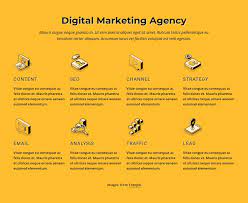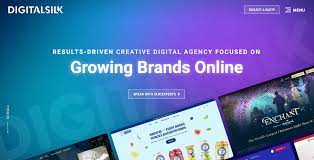The Importance of Digital Marketing in the Financial Services Industry
In today’s digital age, the financial services industry is increasingly turning to digital marketing strategies to reach and engage with customers. With the rise of online banking, fintech startups, and mobile payment solutions, traditional financial institutions are facing stiff competition and the need to adapt to changing consumer behaviors.
Here are some key reasons why digital marketing is essential for financial services:
Reach a Wider Audience
Through digital marketing channels such as social media, search engine optimization (SEO), email campaigns, and online advertising, financial services companies can reach a larger audience beyond their local branches. This enables them to target specific demographics and geographic areas more effectively.
Build Brand Awareness and Credibility
By creating a strong online presence through content marketing, social media engagement, and thought leadership articles, financial services firms can build brand awareness and establish credibility in the eyes of consumers. This helps to differentiate them from competitors and instill trust among potential clients.
Drive Lead Generation and Conversions
Digital marketing tactics such as lead magnets, landing pages, and targeted advertising campaigns can help financial services companies generate leads and convert them into customers. By providing valuable content and personalized offers, firms can nurture prospects through the sales funnel more effectively.
Enhance Customer Engagement and Retention
Through email newsletters, social media interactions, personalized recommendations, and online customer service channels, financial services firms can engage with customers on a more personal level. This leads to improved customer satisfaction, loyalty, and retention rates over time.
Measure Performance and ROI
One of the key advantages of digital marketing is the ability to track performance metrics such as website traffic, conversion rates, click-through rates, and return on investment (ROI). By analyzing these data points regularly, financial services companies can optimize their campaigns for better results.
In conclusion, digital marketing has become an indispensable tool for financial services firms looking to stay competitive in today’s fast-paced digital landscape. By leveraging the power of online channels to connect with customers, drive business growth, and foster long-term relationships, these companies can thrive in an increasingly digital world.
9 Key Advantages of Digital Marketing for Financial Services
- 1. Increased reach to a wider audience through online channels.
- 2. Cost-effective compared to traditional marketing methods like print or TV ads.
- 3. Ability to target specific demographics and geographic areas more precisely.
- 4. Improved brand awareness and credibility through consistent online presence.
- 5. Enhanced lead generation and conversion rates with personalized digital campaigns.
- 6. Better customer engagement and retention through interactive online platforms.
- 7. Real-time performance tracking and analytics for data-driven decision-making.
- 8. Opportunity to experiment with different strategies quickly and adjust in real-time.
- 9. Ability to stay ahead of competitors by adopting innovative digital marketing tactics.
5 Major Drawbacks of Digital Marketing for Financial Services
- 1. Regulatory Compliance Challenges
- 2. Security Risks
- 3. High Competition
- 4. Trust Issues
- 5. Adapting to Technological Changes
1. Increased reach to a wider audience through online channels.
Digital marketing for financial services offers the significant advantage of increased reach to a wider audience through online channels. By leveraging platforms such as social media, search engines, and email campaigns, financial institutions can extend their outreach beyond traditional boundaries. This enables them to target specific demographics, geographic locations, and niche markets more effectively, ultimately expanding their brand visibility and attracting a broader spectrum of potential clients. The ability to tap into online channels allows financial services firms to connect with a diverse audience in real-time, facilitating greater engagement and interaction that can lead to enhanced brand awareness and customer acquisition opportunities.
2. Cost-effective compared to traditional marketing methods like print or TV ads.
Digital marketing for financial services offers a significant advantage in terms of cost-effectiveness compared to traditional marketing methods such as print or TV ads. By leveraging digital channels like social media, email campaigns, and online advertising, financial institutions can reach a larger audience at a fraction of the cost of traditional advertising. This allows companies to allocate their marketing budgets more efficiently and achieve a higher return on investment (ROI) while still effectively promoting their services and products to potential customers.
3. Ability to target specific demographics and geographic areas more precisely.
Digital marketing for financial services offers the distinct advantage of targeting specific demographics and geographic areas with precision. By leveraging tools such as social media ads, search engine optimization, and geotargeted campaigns, financial institutions can tailor their messaging to resonate with particular audience segments based on factors like age, income level, interests, and location. This targeted approach not only increases the relevance of marketing efforts but also enhances the likelihood of reaching individuals who are more likely to convert into loyal customers.
4. Improved brand awareness and credibility through consistent online presence.
Digital marketing for financial services offers the distinct advantage of enhancing brand awareness and credibility through a consistent online presence. By maintaining a strong and active presence across various digital channels, financial institutions can effectively showcase their expertise, values, and offerings to a wider audience. This consistent visibility not only helps in building brand recognition but also instills trust and credibility among consumers, ultimately setting the foundation for long-lasting relationships with clients.
5. Enhanced lead generation and conversion rates with personalized digital campaigns.
Enhanced lead generation and conversion rates with personalized digital campaigns are a significant advantage of digital marketing for financial services. By tailoring marketing messages and offers to specific target audiences based on their preferences, behaviors, and needs, financial institutions can attract higher-quality leads and increase the likelihood of converting them into customers. Personalization creates a more engaging and relevant experience for prospects, building trust and driving them further down the sales funnel towards conversion. This targeted approach not only improves conversion rates but also maximizes the return on investment for digital marketing efforts in the financial services sector.
6. Better customer engagement and retention through interactive online platforms.
Digital marketing for financial services offers the advantage of improved customer engagement and retention through interactive online platforms. By utilizing features such as personalized content, live chat support, interactive tools, and social media engagement, financial institutions can create a more immersive and tailored experience for their customers. These interactive online platforms not only enhance customer satisfaction by providing instant assistance and relevant information but also foster stronger relationships that lead to increased loyalty and retention rates over time.
7. Real-time performance tracking and analytics for data-driven decision-making.
Real-time performance tracking and analytics in digital marketing for financial services provide invaluable insights for data-driven decision-making. By monitoring key metrics such as website traffic, conversion rates, customer engagement, and ROI in real-time, financial institutions can make informed decisions quickly and effectively. This ability to analyze data on the go enables companies to adapt their strategies in response to changing market trends and consumer behaviors, ensuring that their marketing efforts are always optimized for maximum impact and results.
8. Opportunity to experiment with different strategies quickly and adjust in real-time.
One significant advantage of digital marketing for financial services is the ability to experiment with various strategies quickly and make real-time adjustments. Unlike traditional marketing methods, digital platforms offer the flexibility to test different approaches, campaigns, and messaging in a cost-effective manner. This agility allows financial firms to analyze data promptly, identify what works best, and adapt their strategies on the fly to optimize performance and achieve desired outcomes efficiently. The real-time nature of digital marketing empowers financial services companies to stay responsive to market trends, consumer preferences, and competitive dynamics, ensuring they remain agile and competitive in a rapidly evolving landscape.
9. Ability to stay ahead of competitors by adopting innovative digital marketing tactics.
In the fiercely competitive landscape of the financial services industry, the ability to stay ahead of competitors is crucial for long-term success. By adopting innovative digital marketing tactics, financial services firms can differentiate themselves from the competition, capture the attention of their target audience, and lead the way in embracing new technologies and trends. From leveraging artificial intelligence for personalized customer experiences to implementing cutting-edge data analytics for targeted marketing campaigns, staying ahead in the digital marketing realm allows financial services companies to not only survive but thrive in a rapidly evolving marketplace.
1. Regulatory Compliance Challenges
Financial services companies encounter a significant con of digital marketing in the form of regulatory compliance challenges. The stringent regulations surrounding data privacy, financial disclosures, and advertising practices pose hurdles for these firms when executing digital marketing campaigns while adhering to compliance boundaries. Navigating through these intricate regulatory requirements demands careful attention and expertise to ensure that all marketing efforts remain compliant with industry standards and legal guidelines. Failure to do so can result in severe consequences, emphasizing the critical importance of maintaining regulatory compliance in the realm of digital marketing for financial services.
2. Security Risks
One significant drawback of digital marketing for financial services is the heightened security risks associated with handling sensitive financial information. The implementation of digital marketing strategies exposes financial institutions to potential cyber threats and data breaches, putting confidential data at risk. Such security vulnerabilities not only jeopardize the privacy of clients but also pose a threat to the reputation and trustworthiness of the firm. In an era where cybersecurity is paramount, these security risks can have far-reaching consequences for financial service providers, necessitating stringent measures to safeguard against potential breaches.
3. High Competition
In the realm of digital marketing for financial services, one significant drawback is the high level of competition that exists within the digital landscape. The sheer number of players competing for consumer attention online creates a challenging environment where standing out and acquiring new customers cost-effectively becomes increasingly difficult. With so many financial institutions and fintech companies vying for market share and visibility, maintaining a competitive edge and reaching target audiences can pose a significant hurdle for businesses in this sector.
4. Trust Issues
One significant con of digital marketing for financial services is the issue of trust. Establishing trust with consumers in a virtual setting poses challenges for financial institutions, as there are concerns regarding online security, the reliability of information, and the authenticity of digital interactions. With sensitive financial information at stake, customers may hesitate to fully engage with digital marketing efforts out of fear of fraud or data breaches. Overcoming these trust issues requires financial firms to prioritize transparency, security measures, and clear communication to reassure customers and build credibility in the online space.
5. Adapting to Technological Changes
One significant drawback of digital marketing for financial services is the constant need to adapt to technological changes. The rapid evolution of technology demands ongoing updates and investments in digital marketing tools and platforms. This poses a challenge for financial firms, as they must allocate resources to stay current and relevant in the market. Keeping up with the latest trends and innovations can be costly and time-consuming, making it difficult for some companies to maintain a competitive edge in the ever-changing digital landscape.




